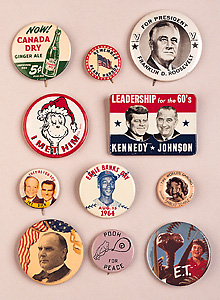Button is a disk or other object used to hold a garment closed. The button is attached to one side of the garment and is passed through a buttonhole or a loop on the other side. Buttons are also used as decoration for clothing. Another type of button–called a pin-back, or lapel, button–consists of a printed message or a picture on the front and a pin on the back. These buttons are pinned to clothing to show support for a candidate or a cause, advertise a product, commemorate an event, or merely communicate a message or slogan.

The word button comes from the French word bouton, which means bud or knob. Clothing buttons are made of such materials as bone, cloth, glass, metal, plastic, shells, and stones. Most pin-back buttons are metal.
History.
Nobody knows exactly when people first used clothing buttons, but archaeologists have found bone buttons that date back to prehistoric times. The ancient Greeks and Romans wore buttons both as ornaments for clothing and as fasteners.
Europeans first used buttons only as decoration for clothing. People used strings, pins, or belts rather than buttons to fasten their clothes. Buttons gained use as fasteners during the 1200’s, when fitted garments became popular. During this time, the buttonhole was invented. People used dozens of bronze or wooden buttons to fasten the front of their clothes. The rich had costly, beautiful buttons of gold or silver set with gems.
During the late 1700’s, portrait and picture buttons became popular in France. Portrait buttons carried the profiles of important men and women. Picture buttons showed trees, flowers, and other scenes. After the French Revolution (1789-1799), buttons with pictures of patriotic subjects, such as war heroes and the French flag, appeared in France. These buttons began the tradition of wearing buttons with a slogan or other message. Pin-back buttons came into widespread use in the United States in 1896, during the presidential race between William McKinley and William Jennings Bryan.
Button legends.
In the 1500’s, buttons were added to men’s coat cuffs. One legend says that these buttons prevented men from wiping their mouths on their sleeves. However, the buttons probably were used originally to close slits at the bottom of the sleeves. Later, coat sleeve buttons became merely decorative.
The custom of placing men’s buttons on the right side of a garment and women’s buttons on the left may have come about because most people are right-handed. According to one theory, buttons were placed on the right side to make it easy for men to get dressed. The arrangement was reversed on women’s clothing to make it easier for maids to dress wealthy women. Another story says that placing buttons on the right enabled men to unbutton their coat with the left hand while drawing a sword or other weapon with the right.
Button collecting
is a popular hobby. Some hobbyists collect clothing buttons, and others collect pinbacks. Button collectors study the history of buttons, and many mount their collections for display. Hobbyists buy, sell, and trade buttons with other collectors and with dealers. Many hobbyists also belong to organizations for button collectors.
